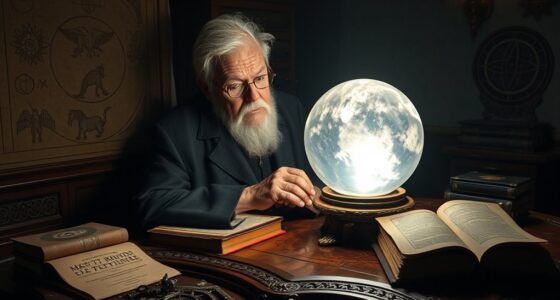You’ll notice that men’s dreams often revolve around symbols of power, action, and achievement like weapons or vehicles, while women’s dreams tend to focus on nurturing, relationships, and emotional bonds. These patterns reflect societal influences and emotional priorities, with men often processing dominance and success, and women exploring intimacy and caregiving. If you keep exploring, you’ll uncover more about how these subconscious themes reveal deeper insights into your inner world.
Key Takeaways
- Men’s dreams often feature symbols of power, achievement, and action, reflecting societal expectations of independence and dominance.
- Women’s dreams tend to focus on nurturing, relationships, and emotional bonds, emphasizing social connection and caregiving themes.
- Emotional themes in dreams differ by gender, with men experiencing pride and anger, while women often process love and vulnerability.
- Dream symbolism patterns are influenced by societal roles, revealing subconscious concerns related to gender-specific social conditioning.
- Analyzing recurring dream symbols and emotions provides insights into gendered subconscious priorities and emotional processing.

Dream content often reflects underlying gender differences, shaping the themes and emotions experienced during sleep. When you analyze dreams through the lens of gender, you’ll notice patterns in dream symbolism and emotional themes that reveal how men and women process their experiences differently. For example, men’s dreams tend to feature more assertive or action-oriented symbols, such as weapons, vehicles, or competitive scenes, which often symbolize power, control, or achievement. Women’s dreams, on the other hand, frequently include symbols related to nurturing, relationships, or emotional connection—like family members, babies, or conversations—highlighting the importance of social bonds and emotional security.
Dreams reveal gender-based themes, with men asserting power and women emphasizing connection and nurturing.
These differences in dream symbolism are closely tied to the emotional themes that dominate each gender’s nighttime narratives. Men often dream about themes of dominance, success, or confrontation, reflecting societal expectations around independence and competitiveness. Their dreams might involve scenarios where they are overcoming obstacles or asserting authority, which serve as subconscious affirmations of their identity and strength. Conversely, women’s dreams tend to focus more on emotional intimacy, caregiving, and relationship dynamics. You might find yourself dreaming of resolving conflicts with loved ones or nurturing someone in need, emphasizing the significance of emotional closeness and support.
The emotional themes in dreams also mirror how each gender typically navigates emotions during waking hours. Men often experience dreams filled with feelings of pride, anger, or fear—emotions linked to control and status. These dreams can be a way of processing feelings that might be suppressed during daily life or unexpressed in social situations. Women’s dreams, meanwhile, are more likely to evoke feelings of love, vulnerability, or anxiety about relationships, reflecting a tendency to prioritize emotional understanding and connection. Additionally, understanding dream symbolism can provide deeper insights into subconscious concerns and societal influences shaping these patterns.
Understanding these gender-based differences in dream symbolism and emotional themes can help you gain insight into your inner world. If you notice recurring symbols or emotions in your dreams, consider how they align with your waking experiences and societal influences. Recognizing these patterns allows you to better interpret your dreams, revealing subconscious concerns and desires. Whether your dreams feature scenes of adventure and conquest or nurturing and emotional exchanges, they serve as a mirror to your inner psyche, shaped by your gendered experiences and social conditioning. Embracing these insights can deepen your understanding of yourself and how you process emotions and symbols during sleep.
Frequently Asked Questions
Do Gender Differences in Dreams Change With Age?
Yes, gender differences in dreams change with age. As you age, you experience age-related changes that influence your dream content, often altering gender-specific patterns. Younger individuals might have dreams reflecting more stereotypical gender roles, while older adults tend to have more neutral or varied themes. These shifts occur due to evolving life experiences, social roles, and psychological factors, shaping how gender influences your dreams over time.
How Do Cultural Factors Influence Dream Content by Gender?
Cultural stereotypes and societal expectations shape your dreams by influencing what you see as acceptable or desirable. You might dream of roles and scenarios aligned with gender norms, reinforcing or challenging these beliefs. These cultural factors steer your subconscious, making your dreams reflect the stereotypes you encounter daily. As society evolves, so do your dreams, blending traditional expectations with personal experiences, creating a complex tapestry of gendered dream content.
Are There Differences in Dream Content Between Transgender Individuals?
You might notice that transgender dream phenomenology often reflects your gender identity and dreams, showing themes of changeover, self-discovery, or gender affirmation. These dreams can differ from cisgender individuals by emphasizing gender congruence or exploration. Your gender identity influences dream content, offering insight into your experiences and feelings. Recognizing these patterns can help you understand how gender identity shapes your subconscious mind and dream symbolism.
Can Dream Content Predict Future Behavior Differently for Men and Women?
Dream content can be like a mirror reflecting your subconscious, but it doesn’t necessarily predict future behavior differently for men and women. Through dream analysis, you might notice gender stereotypes shaping your dreams, yet these don’t directly forecast actions. Instead, dreams reveal underlying feelings or conflicts, helping you understand yourself better. So, while they offer insights, they don’t serve as crystal balls for predicting what you’ll do next.
How Do Hormonal Fluctuations Affect Dream Themes Across Genders?
Hormonal fluctuations considerably impact your dream themes and symbolism across genders. During hormonal shifts, like menstruation, pregnancy, or menopause, you may experience more vivid, emotional dreams that reflect your changing hormonal impact. These dreams often symbolize feelings of vulnerability or transformation. Understanding this connection helps you recognize how your hormone levels influence your subconscious, making your dreams a reflection of your body’s biological responses and emotional states.
Conclusion
You might notice that your dreams reflect your daily experiences and identity, much like a mirror showing different facets of yourself. For example, studies reveal women often dream more about social interactions, while men focus on action and competition. Just as a garden blooms uniquely based on its care, your dreams reveal your personal world. Embrace these differences—they’re the colorful threads in the rich tapestry of our subconscious lives.










